TAIJIQUAN DEFENCE AGAINST FUNDAMENTAL ATTACKS
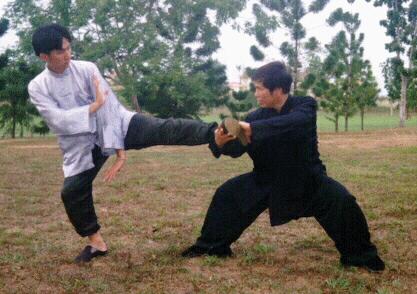
Can Taijiquan be used for combat?
This questions reflects an interesting contrast between Western and Chinese perspective on Taijiquan. Many people in the West may be surprised at the question because they have always thought that Taijiquan, or Taiji as it is more commonly known, is a form of gentle exercise.
Many Chinese will also be surprised at the question, but for a totally different reason. To them the question is redundant. In the Chinese language, "Taijiquan" word by word means "Grand Ultimate Fist". "Fist" here refers not to a clenched hand, but to "martial art".
In a public seminar when I mentioned that Taijiquan was a martial art, a woman from the audience argued passionately that Taijiquan needed not be a martial art. She said she had been teaching Taiji for many years; neither she nor all the Taiji teachers she knew, treated it as a martial art.
I said she had a right to her opinion, but in the past in China everyone without a single exception practised Taijiquan as a martial art. Nevertheless, modernized Taijiquan, as promoted in wushu competitions in China today, is practised as a demonstrative form
Of course, Taijiquan can be used for combat if it is practised as a martial art. In my opinion, it is far superior to many other martial systems for combat. But if you practise it as a gentle exercise or as a demonstrative form, you will never be able to use it for self defence.
The combat sequence below illustrates how Taijiquan can be used to defend against all striking and kicking attacks. Strikes and kicks can come in countless ways and from countless directions. But all these countless ways and directions can be generalized into four categories each, namely
- high
- middle
- low
- sides.
If you know how to counter an opponent striking your nose with his right punch, you would also know how to counter him if he strikes you with his right finger-thrust instead of with his right punch.
Or, if he strikes your eyes or throat instead of your nose, you would also know how to counter, irrespective of whether he uses his right punch or right finger-thrust, or left punch or any other hand forms.
In other words, if you know how to counter a particular high strike, you would also know how to counter other high strikes
The same principle applies to middle strikes, low strikes, and strikes to the sides, as well as high kicks, middle kicks, low kicks, and kicks to the sides.
In a particular combat situation, certain counters may be more advantageous than others, but for the time being we shall learn some fundamental counters against some fundamental attacks. When you are familiar with these fundamentals and can apply them proficiently, you may progress to a higher level where you choose a particular counter, amongst many alternatives, against a particular attack for some good reasons.

|
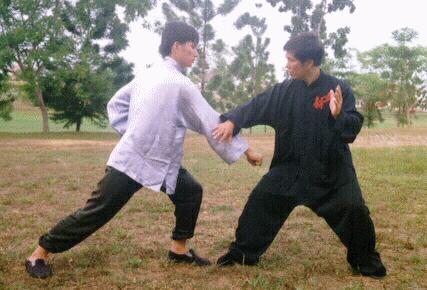
|
In the first illustration, Tai Chee Yong attacks my eyes with a finger-thrust. I counter with the "peng" technique in "Grasping Sparrow's Tail". Tai's attack represents a high strike. It does not matter whether he aims at my eyes or any other parts of my head, or whether he uses a finger-thrust or any other hand-forms for his attack. I can still counter his other high strikes with the "peng" technique.
Tai pushes away my defending arm with his left hand, and using his right hand drives a punch into my solar plexus. Without moving my feet, I shift my body slightly backward and simultaneously use my right hand to brush away the middle strike. In the illustration, I am about to move my body forward and strike my left palm onto Tai's chest or face, using the pattern "Green Dragon Presents Pearl". Tai's punch represents a middle strike, but irrespective of what hand forms he uses, I can still counter with the same pattern.
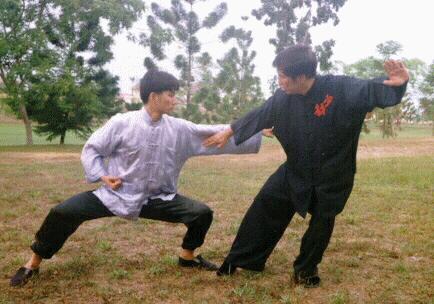
|

|
But before I could counter-attack Tai with my left palm, he changes his stance from bow-arrow to horse-riding, and with his left level fist drives a low punch to my right ribs. This is a low strike, and of course he can use a finger-thrust, phoenix-fist or any other hand form instead of a level fist. I shift my front right leg a small step backward, but still in front of my left leg, and chop at Tai's attacking arm with my left palm, using the pattern "White Crane Flaps Wings".
Tai moves away his left arm to avoid my sweeping attack, and swings his right horn-punch at my left temple. This represents a side strike. Tai could use any other hand forms for the side strike, like a palm chop or a crane beak. He could also use any other stances.
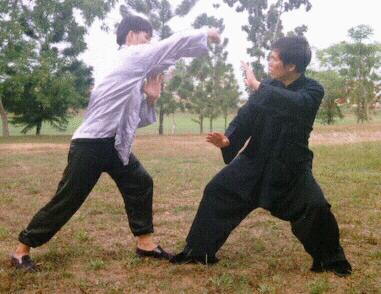
|
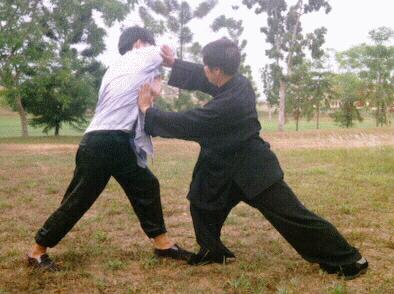
|
I shift my body slightly backward to avoid Tai's attack, and instantly move forward using the pattern "Jade Girl Threads Shuttle" to "float" Tai's attack with my right hand, and strike Tai's right ribs with my left palm.
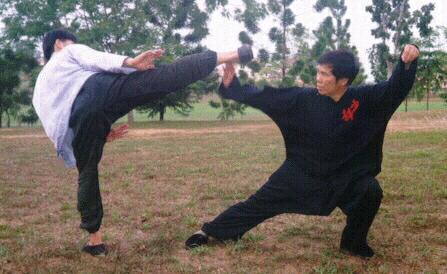
|

|
Tai steps back his left front leg to avoid my attack, immediately turns his body and executes a high kick to my head. Without moving my feet, I move my body backwards to avoid his high kick, using the pattern "Low Stance Single Whip".
Tai brings his right leg back, turns his body and executes a middle kick at my ribs. I glide backward and grip the kicking leg using the "lu" technique of "Grasping sparrow's Tail".
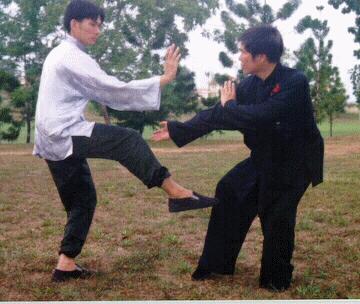
|
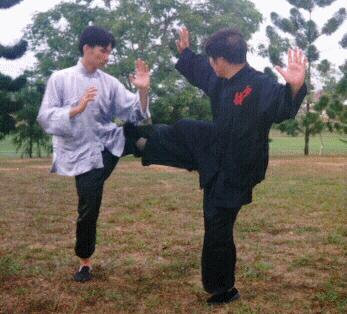
|
Tai quickly withdraws his left leg, and executes a snap low kick at my groins. I bring my front right leg backward, but still in front of my left leg, into a false-leg stance, and chop at the shin of the attacking leg, using the pattern "Needle at Bottom of the Sea".
Tai brings back his right leg, and executes a left whirlwind kick at my right ribs. I move my left leg a small step diagonally to my left, and executes a thrust kick at the thigh of the kicking leg.
Techniques form only one aspect of combat. Other aspects are often more important. Even if you know the appropriate techniques, but if you lack skills, force or speed, you would be unable to execute the techniques effectively.
